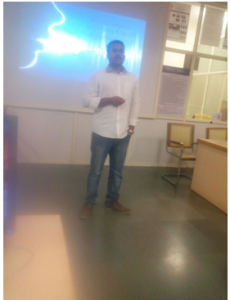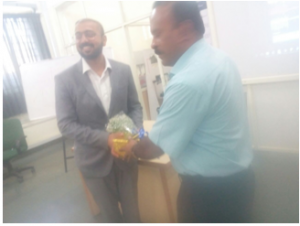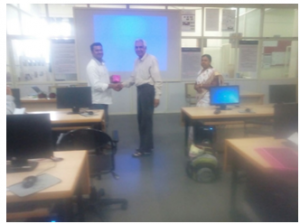IEEE EMB MSRIT Student Chapter in collaboration with IEEE EMB Bangalore Chapter and Department of Medical Electronics organized an one week workshop on Real time signal processing from 19-25, January 2018.
Day 1:
Session 1:
The first session for the day was conducted by Dr. Ratna G N. Her talk covered aspects of hard real time processing in satellite and air traffic controllers.
She gave an introduction into the use of line followers and satellite denoising using FPGA and showed us the various types of noise and the methods used in their restoration process. We also learnt about environment and urban noise level monitoring. She also explained how multirate signal processing could be used in entertainment while acoustic sensor based intrusion detection system could be used in security and surveillance. Other biometric applications like vein recognition system, local binary patterns, adhar cards in healthcare and home automation gave us a broader understanding of the applied aspects.
Session 2:
The next session was conducted by Dr. Manjunath R. His talk was more about the tools and techniques used for real time signal processing.
After giving a brief overview of bioinformatics and the health sector, he began explaining the various biomedical signal processing steps. This included signal acquisition using biosensor, Sensor signal processing, signal enhancement, modeling and reconstruction. We learnt about moving average time series and the auto regressive time series, in the domain of modeling.
Besides signal processing, we also understood ECG data compression, its classification, and the respective component analysis. We explored linear classifiers and did a couple of Case studies to appl the concepts that we learnt.
Day2:
Session 1:
On the next day, Mr. Prabhu began the session by giving his talk on Speech Recognition. He showed us how speech recognition is growing in popularity as technology advances.Alexa, Siri, Cortona are all devices for speech, speaker recognition.
The evolution of speech recognition from radio to hands free kits was mentioned, along with circumstances at which speech recognition can really be helpful. A lot of multidisciplinary tasks like speech processing, human computer interaction, natural language processing, speech recognition and synthesis were discussed in detail.
The classification, types, SR requirements, ASR components, and applications of speech recognition were also an integral part of his talk.
Session 2:
The next session for the day was conducted by Dr. Manjunath G.A. His talk mainly described the various image processing techniques.
Most of the modern day embedded products are done using image processing. 3D imaging technologies and various parameters like stereovision, structured light and time of flight were explained. Open CV, the software used for image processing, was taught in considerable depth, including the basic commands, foundation methods, pixel types BGR,HIS and many more. There were 2 demos, one on OCR applications and the other on object detection, in which edge detection and thresh holding were explained simultaneously.
Day 3:
Session 1:
Nithin Nagaraj was the first speaker for the day. His topic was based on Multi-Resolution Analysis and Application of Wavelets.
He began by explaining the 2d wavelet transforms with the help of haar transforms. An overview of Wavelet based denoising was given, including the need for denoising, Wavelet based method and Fourier-based denoising vs Wavelet-based denoising. He also showed how speech enhancement can be done using denoising.
Next, he gave an introduction to image compression. The differences between lossy and lossless images and their respective file formats were described. The process of transformation, quantization and compression of a generic transform coder was discussed.
Session 2:
Our own professor Mr. Basavaraj Hiremath gave a talk on Wavelet Transforms.
The basics of signals like magnitude and phase response made sure everyone were on the same page. A brief explanation of low pass and high pass filters, along with how differentiators and integrators can perform the same function.
His talk elaborated the properties of Wavelet transforms, finding the wavelet transform for the given input and reconstruction of the signal using inverse wavelet transform
Day 4:
Session 1:
The first session of the day began with the speaker Mr. Ankit Arora, who gave the students a glimpse on medical technology.
The topics that were initially discussed were EEG Analysis and classification for directional recording of wrist movements, Imaging Technologies and an overview of ‘Medtronics’. The speaker further spoke about neurophysiology in neurosurgery, intraoperative neurophysiological monitoring and deep brain stimulation. Recording electrocorticography, electromyogram, signal guidance by neuro-stimulation, motor evoked potentials and ECOG were the other topics included.We also learnt about Broca’s area, Wernicke’s area, neuromodulation and deep brain stimulation for Parkinson’s disease, including its treatment and surgical procedure.
Session 2:
The speaker for the second session was Mr. Srinivas Halvi who spoke about Fusion based face recognition system using 1D transform domains.
The session began with the speaker giving us a glimpse on extracting features and edges, local binary pattern,1D to 2D using mean and Euclidian distance. We later learnt about the features of database and also performance analysis using false rejection ratio, false acceptance ratio and total success ratio. Demonstration using Indian Female Database was the last topic discussed.
Session 3:
The topic for the third session was ‘Speech analysis using MATLAB and Wavesurfer software’ which was presented by the speaker Mr. Sadashiva C.
The speaker started the session by giving the students an overview of Wavesurfer software, voiced and unvoiced signals and pitch contour to differentiate between male and female voice signals, Language development consortium, Electroglottograph and Speech analysis using MATLAB. Two programs on Energy calculation and Autocorrelation were conducted at the end of the session.
Day 5:
Session 1:
Our HOD Dr. N. SriRaam began the session, by giving a talk on Real-time signal processing: The Wearable and Cognitive Neuroscience applications.
His talk began with the use of biomedical signal processing in vital sign analysis. The difference between quality and quantity of processing, along with its generic structure (sensor systems, wearable electrode connections, pre-processing, user interface) was shown.
Various case studies on different implications were explored in detail. The first case study was about treating arrhythmia using simplified ECG amplifiers, accelerometers and a wearable belt. The next one dealt with neurogenerative disorders like Parkinson’s and Alzheimer’s disease. Their corresponding symptoms, clinical assessment, dopamine effects etc. were discussed. The last case study was about telemedicine and data compression along with their important characteristics.
Session 2:
The final speaker for the workshop was Dr. Sanjeev Kubakaddi. He talked on many different aspects of Signal Processing.
He first gave a basic understanding of frequency, showing the use of derivatives to detect the change and kind of change. The properties of signals such as convolution, linearity, impulse response etc. was discussed along with system characterization and filtering.
We got to learn about the various matrix operations in MATLAB. There was a demonstration of a portable brain monitoring system (EEG), its setup, settings, analysis, signal monitoring, scalp map, spectrogram, line noise filter and the recording. The different types of electrodes to measure EEG were also discussed.





